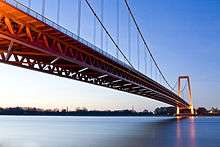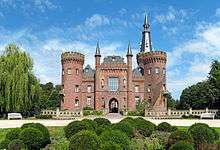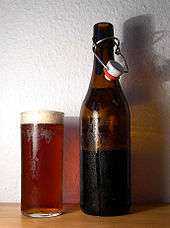Lower Rhine
Lower Rhine (German: Niederrhein) is a region in the state of North Rhine-Westphalia in Germany along the river Rhine below (or geographically - north of) the Cologne Lowland. Apart of the immediate banks of the river, it includes the lowlands extending westwards of it until the Dutch border. Düsseldorf, the state capital of North Rhine-Westphalia, is included in the region, alongside the cities of Krefeld and Neuss facing it across the Rhine. Meanwhile, the city of Duisburg, lying immediately downstream, is not, as it is considered to be the western outpost of the Ruhr region, with the namesake river entering Rhine there.

Cities
.jpg)
- 🌍 Düsseldorf – state capital of North Rhine-Westphalia, known as a media and professional services hub
- 🌍 Emmerich am Rhein - a leisurely town on the Rhine, known for Germany's longest suspension bridge spanning the river
- 🌍 Kevelaer - the largest Catholic pilgrimage location within north-western Europe
- 🌍 Kleve - a prominent city in the Middle Ages and capital of its own erstwhile duchy
- 🌍 Krefeld – former centre of textile industry, going through a transformation process
- 🌍 Meerbusch - a green suburb of Düsseldorf with the most millionaires per capita in the state
- 🌍 Moers - a formerly important industrial hub with quite a bit of heritage from the era
- 🌍 Mönchengladbach - a large city that has been growing continually since the 10th century around a minster
- 🌍 Neuss – founded by the Romans, one of the oldest cities of the region
- 🌍 Xanten – well-preserved ancient Roman heritage
Other destinations
Understand
_(archaeological_park_Xanten%2C_Germany%2C_2005-04-23).jpg)

In contrast with the Middle Rhine Valley and Cologne Lowland, where the river flows surrounded by progressively tapering hills, Lower Rhine is quite flat. The absence of changes in elevation has helped agriculture develop since the early ages. The region is adjacent to Limburg in the Netherlands, which is aligned along the river Maas, which together with the Rhine provided ample opportunities for trade and later early industry to develop.
Lower Rhine was the seat of some of the oldest states of the German Empire, including the Duchy of Cleves (Kleve) and the Duchy of Berg, whose capital was Düsseldorf. Some settlements, such a Neuss, date back even farther to ancient Roman times. The industrial revolution concentrated in the Ruhr region has spread to Lower Rhine as well, and it retains much affluence to this day, which provides for an interesting mix of built heritage, with a variety of urban and rural landscapes.
Talk
Most inhabitants of the region speak a fairly standard form of High German in everyday life, especially in the large cities where a big part of the population stems from other localities or even countries. The traditional regional dialect is Low Rhenish, which differs very much from standard German and is related closely to modern Dutch, but its use is very limited nowadays.
As many of the region's cities depend on international trade economically, feature seats of globally active companies and sizeable student and higher-educated populations, you will find foreign languages spoken by many. English is ubiquitous, while other languages are spoken by more than the usual share of population. Particularly large minorities include the Turks, Poles, Italians and Greeks, while an unusual feature of Düsseldorf is the presence of a large Japanese expat community, totalling up to 2% of the city's population.
Get in

By plane
Düsseldorf Airport (DUS IATA) is a major international hub with a wide range of connections. The region's second-largest airport is the Niederrhein Airport (NRN IATA) near Weeze, a little town about 25 km south of Kleve, a former military airstrip, now used by low-cost carriers like Ryanair.
By train
The only city in the region that sees high-speed train connections is Düsseldorf. For other destinations in the Lower Rhine region, one needs to change from a long-distance to a regional train either in Düsseldorf or in Duisburg or Essen in the Ruhr region, who also see such service.
Düsseldorf is reached by high-speed trains (ICE) from practically every large German city, as well as some Swiss and Austrian cities. Every two hours there is an ICE from Amsterdam. Thalys links Düsseldorf with Paris four times a day. Once a day an intercity train runs from Berlin to Krefeld, Viersen, Mönchengladbach and Geilenkirchen. All tickets except for Thalys tickets can be bought via the DB website.
Intercity buses serve the major cities with connections throughout Germany as well as the Netherlands.

Get around
The region is served by various public transportation bodies united in Verkehrsverbund Rhein-Ruhr, which provides for unified ticket and fare structure. The lines covered include RegionalExpress and RegionalBahn trains, 11 S-Bahn and 19 Stadtbahn light rail lines, 45 streetcar (Straßenbahn) lines in several cities and even monorails in Dortmund and Wuppertal. This is complemented by close to a thousand bus and trolleybus lines.
See

Like other parts of Germany, the region was long divided into a large number of tiny territories, each ruled by an earl, baron or bishop. This has resulted in a rich heritage in castles, palaces and manors, typically surrounded by a moat. Among them are Schloss Moyland in Bedburg-Hau (9 km southeast of Kleve), a romantic water castle that gets close to the prototype of a fairytale castle, Schloss Dyck (11 km southeast of Mönchengladbach), a beautiful baroque palace surrounded by a remarkable landscape garden, Düsseldorf's imposing Schloss Benrath, or Burg Linn of Krefeld.
.jpg)
Kleve stands out with its extensive parks and gardens, dating back to the baroque era. The "Museum Island" Hombroich of Neuss is a mix of park and art exhibition. The Maas-Schwalm-Nette nature park crosses the border to the Netherlands and includes Europe's first sequoia farm. The Roman heritage of Xanten can be encountered in the town's archeological park.
Do
Eat
Drink

The region's most popular drink is Alt beer, which is top-fermented, dark and malty. Next to the market leader Diebels from Issum, there is a number of smaller, local breweries, especially in Düsseldorf, Krefeld and Mönchengladbach. It is mostly drunk pure, but may be mixed with cola ("Krefelder") or fruit punch ("Altbierbowle").
Just like the traditional rivalry between Düsseldorf and Cologne, there is a long-cherished aversion of Alt drinkers against the Cologne region's Kölsch beer (top-fermented as well, but fair-coloured, light and smooth), and vice versa. Ordering a Kölsch in a pub north of the Kölsch-Alt frontier (that runs through Grevenbroich, Dormagen and Monheim) is considered a gaffe and will be answered with ignorance or a sarcastic comment at best.